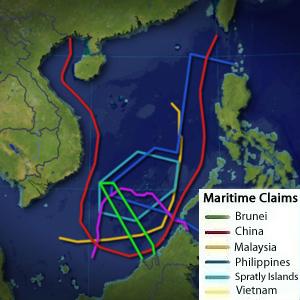Political Minutes: Spotlight on the South China Sea
 On the evening of Thursday, November 1, 2012, Columbia Law School hosted a panel discussion called “International Law and the South China Sea.” Panelists included Zhou Jian, UN ambassador for the People’s Republic of China and an advisor on maritime law for the PRC; Vietnam’s UN ambassador Le Hoai Trung; Henry Bensurto of the Philippines’ Department of Foreign affairs; Sir Daniel Bethlehem, visiting law professor at Columbia and a former legal advisor to the UK’s Foreign and Commonwealth Office; Harold Koh, a legal advisor to the US Department of State; and Coalter Lathrop, founder of Sovereign Geographic, an international boundary consultancy. The University of Miami Law School’s Bernard Oxman served as moderator.
On the evening of Thursday, November 1, 2012, Columbia Law School hosted a panel discussion called “International Law and the South China Sea.” Panelists included Zhou Jian, UN ambassador for the People’s Republic of China and an advisor on maritime law for the PRC; Vietnam’s UN ambassador Le Hoai Trung; Henry Bensurto of the Philippines’ Department of Foreign affairs; Sir Daniel Bethlehem, visiting law professor at Columbia and a former legal advisor to the UK’s Foreign and Commonwealth Office; Harold Koh, a legal advisor to the US Department of State; and Coalter Lathrop, founder of Sovereign Geographic, an international boundary consultancy. The University of Miami Law School’s Bernard Oxman served as moderator.
As the diverse background of the panelists suggests, the issue of sovereignty, borders, and rights to resources in the South China Sea is contentious and has many different sides. As Asia continues to develop economically and the hunger for resources is felt more acutely, countries bordering the South China Sea have scrambled to stake out their claims to any cay, island, or rock they can, hoping to eventually exploit the bonanza of oil and gas beneath the water (as well as take advantage of plentiful fisheries). Tensions in the region have greatly escalated as a result, with threats and standoffs between competing navies becoming the norm. As the State Department panelist Koh stated during the discussion, this is the “most important and least well understood issue in international law in our time.” With tensions and nationalist sentiment rising across Asia, he may certainly be correct.
Lathrop, founder of Sovereign Geographic, opened the discussion by shedding light on the specific overlapping claims of each party. The picture at the head of this column shows a rough outline of the overlapping claims—as you can see, it’s a huge mess. China, Taiwan, the Philippines, Vietnam, Malaysia, and Brunei each have conflicting claims. Although the South China Sea includes thousands of tiny islands, the two main groups of islands in dispute are the Paracel Islands and the Spratly Islands. The Paracels are occupied in their entirety by China, and are claimed by only one other country—Vietnam. The Spratlys, on the other hand, are claimed in their entirety by both China and Vietnam, with the Philippines, Malaysia, and Brunei also staking out overlapping claims.
If this all seems a little bit confusing, that’s because it is. Matters are further complicated by the fact that each of these countries (save tiny Brunei) have already occupied many of the larger islands (which in the case of this sea means about one square kilometer). The result is a tense checkerboard of doom, with boats of rival nations constantly rubbing shoulders, each confident that the waters and islands they occupy belong rightfully to their respective nation.
All of the panelists, in their own way, attempted to elucidate the central problems posed by Lathrop; Whose land is it?, what is the effect of owning it?, and what do the lines on the map mean? The Philippine diplomat, Bensurto, pushed the point that sovereignty over land formations and sovereignty over water must be completely separate, and made clear that the Philippines’ claim in the Spratly Islands had no bearing on the surrounding water, which in turn implies a more liberal viewpoint on trade happening within the sea. As 40 percent of the entire world’s maritime traffic passes through the South China Sea, the claims of other nations like China make some analysts uneasy about what such a claim means for China’s view of trade vessels passing through the sea.
The Chinese representative vehemently defended China’s sovereign right to the islands in the sea, and argued that China’s famous nine-point line (a.k.a the “cow’s tongue), which delineates almost 90 per cent of the South China Sea as being Chinese sovereign territory, was non-negotiable and had historical evidence to back it up. The other panelists tended to disagree with the Chinese view of sovereignty, and favored a more balanced, multilateral approach to establishing mutual ownership over the Sea. In the end, however, each representative was as indelible as the Chinese side on their claims, and it became increasingly clear why there has not been and probably will not be any progress on carving up the South China Sea in the near future. Such a complex question with so many different angles seems impossible to settle, because each side has conflicting interests. The panel left these questions ultimately unanswered, further highlighting the irresolvable of this issue.
On the sunny side, in this panel, as in endless public statements from governments on all sides of the conflict, all parties agreed that only diplomacy and international agreements could resolve the conflict over the South China Sea. Although it may take decades (or even centuries) to untangle the interwoven claims and settle old disputes, the commitment to diplomacy over force will be essential to prevent a major escalation into all-out regional war.
